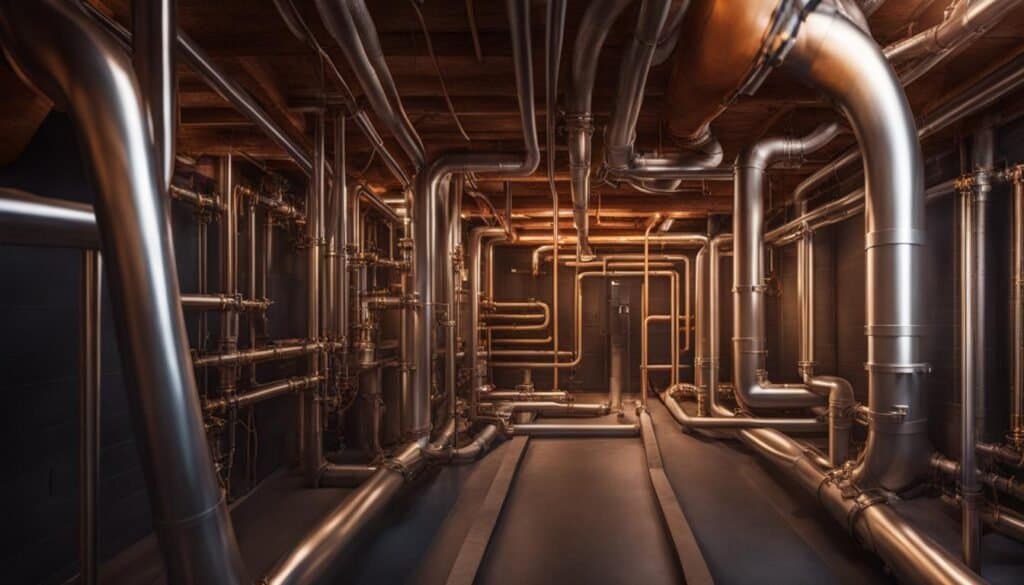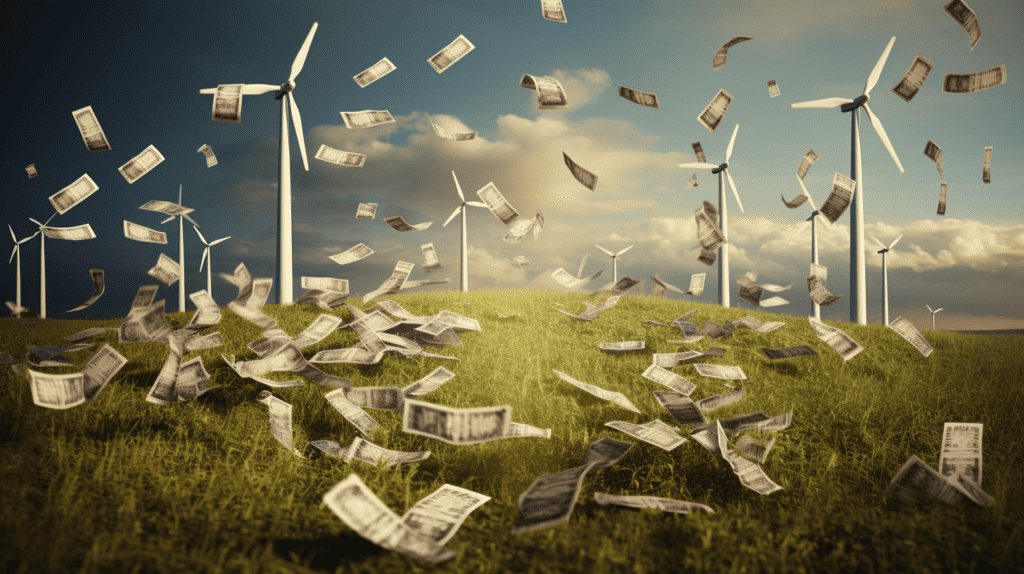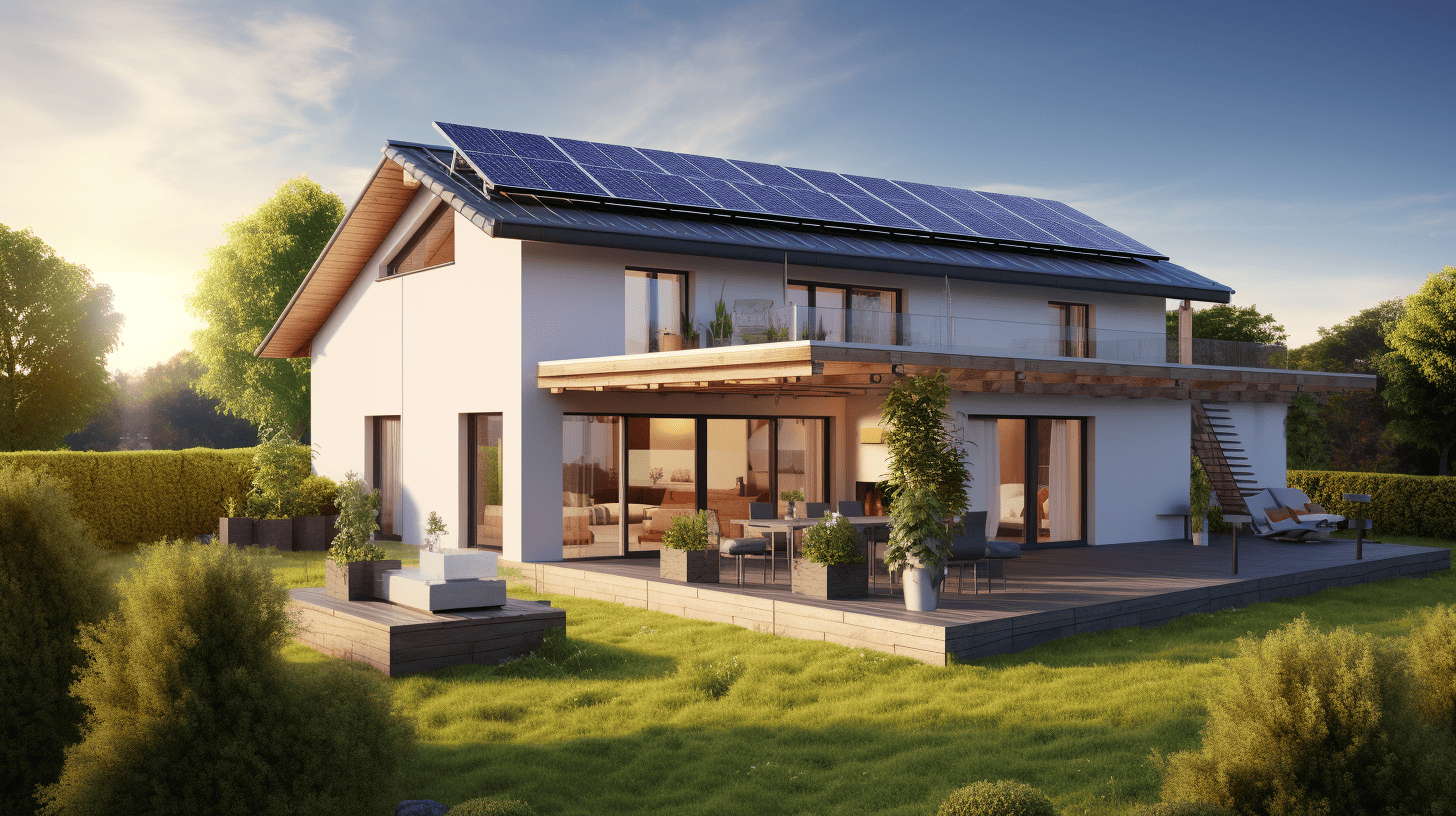As a homeowner, I’ve often heard about the benefits of adopting renewable energy systems for homes but never really explored what that meant. This comprehensive guide will dive deep into various renewable energy options such as solar power, wind energy, geothermal heat, and microhydropower, discussing their benefits and practicality for an energy-efficient home.
We will also cover the different types of renewable energy systems, including grid-tied systems, off-grid systems, and hybrid systems. With a better understanding of these systems, you will be better equipped to decide which is best for your own home. Let’s embark on this journey to a greener, more sustainable future using renewable energy systems!
Key Takeaways
- There are various renewable energy solutions for homes, including solar power, wind energy, geothermal heat, microhydropower, and more.
- Grid-tied systems, off-grid systems, and hybrid systems are the main types of renewable energy systems available for homes.
- Adopting renewable energy systems contributes to an energy-efficient home, reduces carbon footprint, and may even save you money in the long run.
- Proper planning and understanding local regulations are important when considering which renewable energy system to invest in.
- Working with professionals and reputable brands ensures the best outcomes when transitioning to renewable energy systems for homes.
Embracing the Sun: The Power of Residential Solar Energy Systems
Residential solar power systems harness the sun’s power to provide clean and sustainable energy to homeowners. While the initial investment may seem daunting at first, these systems provide long-term benefits in terms of energy independence, cost savings, and environmental impact.
Understanding Solar Panels and Their Installation
A solar panel system consists of photovoltaic cells, which convert sunlight into electricity. The installation process includes assessing your roof’s suitability, securing the solar panels, connecting to an inverter, and potentially integrating with the electrical grid. A professional installer evaluates factors like orientation, tilt, and shading to optimize panel placement, maximizing solar efficiency for electricity generation.
Benefits of Solar Energy on Your Electricity Bills and Carbon Footprint
One of the main advantages of solar energy is the potential for cost savings on electricity bills. By generating your own power, you can reduce electricity bills and gain control over your energy expenses. Homeowners may also be eligible for various solar incentives like the Solar Investment Tax Credit, rebates, and solar renewable energy certificates (SRECs), which offset the initial cost of the system.
Today’s Homeowner recommends installing solar panels, which can be roof-mounted or ground-mounted, to convert sunlight into electricity. This system can offset about 75% of an average home’s electricity needs and is ideal for homes in sunny regions.
Adopting solar power not only helps you save on energy bills but also contributes to carbon footprint reduction by producing clean electricity and reducing reliance on fossil fuels.
To further enhance the benefits of going solar, homeowners are encouraged to improve home energy efficiency through Energy Star appliances and other measures, which complement the solar system to create a more sustainable energy solution.
Maximizing Efficiency: Right Angles and Bright Outcomes
The efficiency of solar panels plays a critical role in determining the energy production and overall benefits of your solar installation. Optimal panel angles vary based on location, climate, and other factors, but generally, south-facing roofs with a slope between 15 and 40 degrees perform best.
| Panel Angle | Efficiency Factors | Benefits |
|---|---|---|
| 15-25 degrees | Compatible with most roof slopes, good sun exposure | Energy production, moderate solar cost savings |
| 25-35 degrees | Higher energy production, adequate sunlight exposure | Maximized solar efficiency, increased cost savings |
| 35-40+ degrees | Higher slopes might require more bracketing, less common roof angles | Likely suitable for specific climates and solar energy production goals |
Even if your roof deviates slightly from the ideal slope or orientation, your solar system may still achieve excellent results. A professional installer can help you determine the best approach for your specific situation, ensuring that the financial and environmental outcomes of adopting solar power align with your expectations.
Catching the Wind: Investing in Home Wind Energy Solutions
Home wind energy solutions involve installing small wind turbines that utilize wind power to generate cost-effective, clean, and renewable electricity. Successful installation requires adequate space, an assessment of local wind resources, and adherence to local government regulations. While noise and visual impact are considerations, wind energy greatly decreases reliance on traditional power grids and fossil fuels, promoting energy independence and environmental stewardship.
Home wind energy is an excellent option for those looking for a green energy solution that complements other renewable power sources like solar. Wind energy has several benefits, such as flexibility in installation locations, a minimal carbon footprint, and its ability to coincide with other energy technologies.
“Wind does not always blow and the sun does not always shine” – This saying highlights one of the significant advantages of incorporating wind electricity generation into a renewable energy plan. When solar power production is low, wind energy can pick up the slack and vice versa, ensuring a consistent flow of renewable power for your home.
Key Checklist for Installing a Home Wind Energy Solution
- Evaluate your local wind resource – Ensure that the average annual wind speeds are high enough to make the project feasible.
- Assess space requirements – Check for adequate land and clear space around the turbine to minimize turbulence and optimize power production.
- Comply with building codes and regulations – Adhere to local government requirements to ensure safety and legal compliance.
- Choose the right wind turbine system – Consult professionals to determine the appropriate system size and type for your energy needs.
- Consider aesthetics and impact on neighbors – While wind turbines are a source of green energy, be aware of the potential visual and noise impact on your surroundings.
| Wind Turbine Type | Power Output | Ideal Application |
|---|---|---|
| Vertical axis wind turbine | Up to 10 kW | Residential homes, urban areas |
| Horizontal axis wind turbine | Up to 100 kW | Rural areas, small communities |
| Large-scale wind turbine | Over 100 kW | Commercial wind farms, industrial applications |
By investing in home wind energy solutions, homeowners benefit from decreased reliance on traditional power sources and increased energy independence. Careful planning and professional guidance can help ensure you select the right small wind turbine system to meet your unique renewable power needs and contribute to a greener future.
The Underfoot Powerhouse: Geothermal Systems for Heating and Cooling

Geothermal heat pumps are gaining popularity for their ability to harness the Earth’s stable temperatures in providing energy-efficient heating and cooling solutions to homes. These sustainable home energy systems represent a long-term investment with lower maintenance compared to traditional systems, ultimately contributing to sustainable living and eco-friendly heating and cooling.
How Geothermal Heat Pumps Harness Earth’s Stable Temperatures
A geothermal heat pump system comprises a heat pump unit, underground loops, and a distribution system that work together to regulate indoor temperatures. The key to this system’s efficiency lies in the Earth’s thermal properties, where below the surface, stable temperatures can be found year-round.
The heat pump unit extracts heat from the underground loops during winter months for heating purposes and reverses the process in summer, using the loops to dissipate heat back into the ground for cooling. This efficient temperature regulation helps maintain comfort levels in your home, all while utilizing a renewable and sustainable energy source.
Geothermal heat pumps leverage the Earth’s stable subterranean heat for energy-efficient heating and cooling.
Long-term Savings and Sustainable Living with Geothermal Solutions
Investing in a geothermal heat pump system can lead to long-term energy savings, thanks to its efficient operation aligning with sustainable living practices. Utilizing eco-friendly energy sources reduces the reliance on fossil fuels and minimizes your overall carbon footprint, ultimately promoting a more sustainable lifestyle.
The Department of Energy advises that planning for a home renewable energy system should include analyzing your existing electricity use, understanding local codes and requirements, and considering whether to operate the system on or off the electric grid.
Another benefit of geothermal systems is their low-maintenance nature compared to traditional heating and cooling systems. With fewer moving parts, these systems require less upkeep and have longer equipment life, helping you save more in the long run.
Government incentives may also be available to support the adoption of renewable energy systems in residential settings. These incentives can help offset some of the initial investment costs, making geothermal solutions even more appealing.
| Geothermal Heat Pumps Pros | Geothermal Heat Pumps Cons |
|---|---|
| Energy-efficient heating and cooling | Higher initial investment |
| Utilizes a sustainable energy source | Site-specific installation requirements |
| Low maintenance | May require drilling or excavation |
| Long-term cost savings | Limited availability of government incentives depending on location |
In conclusion, geothermal heat pumps offer energy-efficient heating and cooling solutions, contributing to sustainable living and long-term energy savings. By harnessing stable temperatures beneath the Earth’s surface, these eco-friendly systems provide an environmentally responsible alternative to conventional home comfort solutions.
The Power of Water: Microhydropower Systems for Residential Use
For homeowners situated near flowing water sources such as streams and rivers, microhydropower systems present an attractive solution for generating clean, renewable energy. These water-generated electricity solutions offer eco-friendly and cost-effective benefits by harnessing the kinetic energy of flowing water.
Residential hydropower, achievable through microhydropower systems, can produce up to 100 kilowatts of clean electricity, which is often sufficient to power large homes or even small communities. Moreover, microhydropower systems have minimal environmental impact, making them a responsible choice among renewable power sources.
“Microhydropower systems are small-scale solutions for generating electricity from water flow, suitable for homes located near streams or rivers.”
Here’s a quick look at the key components of a microhydropower system and the advantages they provide:
- Water source: Streams and rivers with a steady flow provide the energy required to generate electricity.
- Turbine: Rotating blades convert the water’s kinetic energy into mechanical energy.
- Generator: The mechanical energy from the turbine is transformed into electrical energy with a generator.
- Transformer: The electrical output is then conditioned and distributed for residential use.
Before deciding on a microhydropower system, you should consider various factors:
- Flow rate: The amount of water flowing per second, which influences the system’s generating capacity.
- Head: The height difference between the water’s upper and lower levels, which affects the system’s efficiency.
- Local regulations: Comply with permitting requirements and any environmental impact assessments.
- System design: Choose the right type of turbine for your specific water source and flow conditions.
Installing a microhydropower system can be a significant investment; however, the long-term savings in energy costs and the environmental benefits of water-generated electricity make it a viable option for those with access to suitable water sources.
Hybrid Systems: Combining Wind and Solar Power for Year-Round Energy

The Synergy of Hybrid Energy Systems
By combining solar and wind power, hybrid energy systems maximize the potential of year-round renewable energy generation. The major advantage of this approach is the system synergy that compensates for the fluctuations in availability of solar and wind resources. When the sun is not shining, wind resources might be available, ensuring a continuously generating green power solution.
Hybrid energy systems provide a reliable alternative to single-source renewable options and optimize energy independence for homeowners.
Another key feature of hybrid energy systems is their potential to reduce reliance on the grid or even enable homeowners to become completely off-grid. Furthermore, these systems have the potential to offer cost savings by utilizing excess energy generated by one resource, such as solar during the peak summer months, to compensate for periods when the other resource, such as wind, is less abundant.
Designing a System that Meets Your Needs
Designing an effective hybrid system requires a custom renewable energy solution that takes into account various factors such as personal energy needs, available space for system installation, and local climate. To create a tailored hybrid system, consider the following important factors:
- Individual household power consumption patterns
- Available space for solar panels and wind turbines
- Potential system siting and optimal orientation towards sunny or windy areas
- Local climate, including average sunlight hours and wind speeds
- Renewable resource availability and peak operating times
| Solar Energy System | Wind Energy System | Hybrid System |
|---|---|---|
| Highly reliant on sunlight | Requires consistent wind supply | Fuses solar and wind resources for optimal generation |
| Peak production during summer months | More consistent production year-round, depending on location | Consistent generation throughout the year, depending on resource availability |
| Easier to implement in urban settings | Typically requires larger open spaces | Requires a custom combination of solar and wind systems tailored to local conditions |
With a professional assessment of your energy needs, a tailored hybrid energy system can be designed to ensure efficient energy production as well as potential savings on electric utility bills. In summary, hybrid energy systems optimize the use of renewable resources by combining wind and solar power, creating a resilient and reliable solution for an eco-friendly, sustainable future.
Energy Storage Solutions: Batteries and Beyond

As the popularity of renewable energy systems grows, so does the need for effective energy storage solutions. Modern energy storage batteries cater to a variety of needs, from storing excess solar power for use during the night, to providing backup power solutions during power outages. Let’s take a closer look at some popular battery options and their key features.
- Lead Acid Batteries
- Lithium-ion Batteries
- Flow Batteries
Choosing the right renewable energy storage option depends on factors such as the size of your renewable energy system, your energy consumption patterns, and your budget. Homeowners with grid-tied battery systems can enjoy added benefits like energy independence and resilience against power outages while maintaining a connection to the grid for additional support when needed.
Comparing Battery Options
Not all solar batteries are created equal. To ensure you’re making the best decision for your home’s energy storage system, it’s essential to understand the key differences between various battery options.
| Battery Type | Price | Lifespan | Efficiency | Discharge Depth |
|---|---|---|---|---|
| Lead Acid | $ | 3-8 years | 60-75% | 50% |
| Lithium-ion | $$ | 8-15 years | 85-95% | 90% |
| Flow | $$$ | 10+ years | 70% | 100% |
While comparing different energy storage solutions, consider more than just the initial cost. Factors such as energy efficiency, lifespan, and discharge depth will directly impact your renewable energy system’s performance and overall savings.
Investing in a reliable energy storage solution is an essential part of optimizing the benefits of your renewable energy system for the long term.
Ultimately, the best energy storage solution for your renewable energy system will depend on your specific needs, preferences, and budget. By understanding the options available and taking your personal requirements into account, you can invest in a solution that maximizes the return on your renewable energy investment and helps you move towards a more sustainable and energy-independent future.
Financing Renewable Energy: Incentives, Loans, and Rebates

Investing in renewable energy systems can be a significant financial commitment for homeowners. However, various government incentives, financial support programs, and loans can help offset the cost of renewable installations. Understanding the available options empowers homeowners to make informed decisions about investing in clean energy solutions.
Navigating Government Incentives and Financial Support for Renewable Installations
Given the increasing emphasis on clean and sustainable energy, many state and federal governments offer financial incentives that encourage homeowners to adopt renewable energy systems. Some common forms of financial support include energy rebates, grants, and tax incentives. A comprehensive source of information on these government incentives is the Database of State Incentives for Renewables & Efficiency (DSIRE), which provides details on programs across the United States.
DSIRE: A comprehensive source of information on government incentives and support available for renewable energy systems at state and federal levels.
Besides government incentives, homeowners can take advantage of federal tax credits, such as the Solar Investment Tax Credit (ITC), which offers a percentage off the cost of a solar energy system, reducing the overall expense.
- Energy rebates: Often provided by utility companies or state governments, these reduce the cost of renewable energy systems.
- Grants: Certain states or organizations may provide grants to help fund renewable energy installations for eligible participants.
- Tax incentives: Federal and state tax credits can help offset the cost of renewable energy systems by reducing tax liability.
Understanding Solar Loans and Tax Credits
Another crucial aspect of funding renewable energy systems is understanding solar financing options. Solar loans, leases, and power purchase agreements (PPAs) are common means for homeowners to obtain financing for solar panel installations. Each option has its benefits and drawbacks, depending on individual needs and preferences.
| Financing Option | Description | Benefits | Considerations |
|---|---|---|---|
| Solar Loans | A loan specifically designed to finance solar panel installation with various terms and interest rates. | Lower up-front cost; loan payments may be less than typical energy bills; potential to qualify for tax credits. | Interest payments; homeowner is responsible for the system’s operation and maintenance. |
| Solar Leases | A contract where the homeowner leases the solar panel system from a third-party provider who owns and maintains the system. | No upfront cost; provider handles maintenance; fixed monthly lease payment. | No eligibility for tax credits or rebates; long-term commitment. |
| Power Purchase Agreements (PPAs) | A contract where a third-party provider installs and maintains a solar panel system on the homeowner’s property; the homeowner buys the electricity generated by the system at a fixed rate. | No upfront cost; lower electricity rates; provider maintains the system. | No tax credit or rebate eligibility; the homeowner does not own the system. |
Understanding the options and resources available for clean energy financing can make renewable energy more accessible and affordable. By exploring the available incentives, loans, and rebates, homeowners can invest in renewable energy with greater confidence and enjoy the benefits of an eco-friendly, energy-efficient home.
Legal Landscape and Permitting: What to Know Before You Install
Installing a renewable energy system at your home requires adhering to several essential prerequisites. This includes understanding and complying with local building codes, acquiring the necessary installation permits, navigating any complications resulting from easements or homeowner association regulations, and being aware of any applicable solar rights laws in your area. By taking these steps, you can ensure that your installation goes smoothly and that you can enjoy the benefits of renewable energy worry-free.
Codes, Regulations, and Rights – Preparing for a Smooth Installation
Before beginning the installation process, it is essential to research and meet all relevant legal requirements. This can help you prevent unsafe installations and unforeseen complications during and after the project. Here are some crucial aspects to consider:
- Building codes: Local building codes typically dictate structural, electrical, and fire safety standards for residential and commercial buildings.
- Local ordinances: Municipal and county governments may enforce additional zoning, noise, and aesthetic regulations specific to renewable energy installations.
- Renewable energy regulations: Some government agencies and utility companies impose rules on renewable energy systems. These rules may include requirements for grid-connectivity, metering, interconnection agreements, and other necessary steps before utilizing your renewable energy system.
- Installation permitting: Building codes and regulations generally require permits before installing new renewable energy systems. Acquiring these permits involves submitting detailed plans, system specifications, and any environmental assessments mandated by your local government.
- Solar rights laws: These laws protect homeowners’ rights to install and utilize solar energy on their properties, preventing unreasonable interference by local governments, homeowner associations, or other restrictive covenants. Be aware of these laws in your area to ensure your rights are respected during the installation process.
As you navigate these legalities, keep in mind that local governments, utility companies, and industry organizations often provide resources and assistance in understanding codes, regulations, and permitting requirements. This support can help expedite your renewable energy system installation and enable you to enjoy the benefits of sustainable living hassle-free.
Conclusion on Renewable Energy Systems for Homes
Adopting renewable energy systems for our homes is a crucial step towards a greener and more sustainable living. By exploring various eco-friendly power options like solar, wind, and geothermal energy, we can find sustainable home solutions that not only benefit the environment, but also provide significant cost savings and energy independence.
However, transitioning to renewable energy requires careful consideration of our personal needs, our local climate, and available resources. With the help of professional guidance, we can design and install custom systems that align with our values and practical requirements, ensuring a seamless transition to greener, more energy-conscious decisions.
By making the choice to adopt renewable energy, we contribute to a cleaner and more sustainable future, allowing us to enjoy the benefits of green living while taking responsibility for the wellbeing of our planet and its resources.
FAQ on Renewable Energy Source
Q: What are the benefits of using renewable energy sources for homes?
A: Using renewable energy sources for your home is beneficial as it helps in reducing your carbon footprint, lowers electricity bills, and provides a more sustainable energy source.
Q: How can I power my home with renewable energy?
A: You can power your home with renewable energy sources such as solar panels, wind turbines, or geothermal systems to generate electricity or heat your home.
Q: What are the best renewable energy sources for homes?
A: The best renewable energy sources for homes include solar energy, wind power, and geothermal heating systems, providing efficient and sustainable ways to power your home.
Q: What are some ways to power a home using renewable sources?
A: Some ways to power a home with renewable energy sources include installing solar water heaters, using solar panels for electricity, or harnessing wind power through turbines.
Q: How do renewable energy systems help in increasing energy efficiency at home?
A: Renewable energy systems help in increasing energy efficiency by providing a sustainable and clean source of power, thus reducing energy wastage and minimizing environmental impact.
Q: Can I heat my home using renewable energy sources?
A: Yes, you can heat your home using renewable energy sources such as solar water heaters or geothermal heating systems, which are efficient and eco-friendly solutions.
Q: What are the types of renewable energy options available for homes?
A: The types of renewable energy options available for homes include solar energy, wind power, hydroelectricity, and biomass, offering a diverse range of sustainable energy sources.
Q: Are there government incentives for using renewable energy at home?
A: Yes, the Department of Energy provides incentives such as tax credits and rebates for homeowners using renewable energy systems, encouraging the adoption of sustainable power solutions.
Q: How much power can be generated from renewable energy sources for homes?
A: The amount of power generated from renewable energy sources for homes varies depending on the system used, but it can efficiently meet a significant portion of your electricity needs.
Q: What are the energy-saving benefits of using renewable energy sources at home?
A: Using renewable energy sources at home helps in saving energy by reducing reliance on non-renewable resources, lowering energy use, and decreasing overall carbon emissions.





Leave a Reply